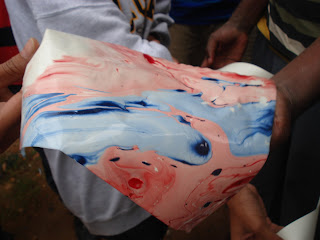
One of the main tasks was making Recycled hand made paper.
The Process: The first step is to soak waste paper in water for 42 days. The beater machine then beats the waste paper along with cotton fiber. The ratio is about 50% of both. To prevent blotting, rosin and alum is added. Rosin is first diluted in caustic soda.
The mold is made of fine nylon net over a frame of 
Handmade paper making.
Making a mask out of the pulp was our next agenda. The paper pulp is taken and squeezed dry. Its pound to a fine substance and a glue is made using maida (refined flour + water, boiled together ) and it is mixed into the pulp. The mask is made and left out to dry. It takes a long time to dry, roughly about a week. After the mask is dry, it is painted, preferably using acrylic colours, even poster paints can be used.
Masks and newspaper container.
Since newspaper is already recycled it can’t be reused for the pulp. But we did find some good uses for it. Stephen taught us to make two types of paper bags, a folder, a bowl and a lantern using newspaper. Making the folder involved weaving of paper strips. For the bowl the paper strips were wound up till they were big enough and the center could be pushed to give it dimension and depth.
We also did Paper marbling. Enamel paint was put in water and blown into, and paper was placed on top and when the paper was taken out it had lots of interesting swirling patterns.
Marbling, Folder, Lantern and Binding
Stephen also taught us how to make tissue paper flowers, folders out of handmade paper and binding.
On the last day at Visthar, we made Banana fiber paper. The process is long and elaborate.
The outer part of the banana stem is used. It is then boiled with caustic soda for 8 hours. For cleaning, the fiber is soaked in water and the water is squeezed out. This process is repeated several times. The fibre is bleached and put into the beater to make pulp. To provide strength to the paper, cactus or lady’s finger (okra) juice is added to the final pulp. The whole process is 3 days long.
Banana paper is also used as a part of currency notes as it has excellent folding properties and it is strong.
For our final project we were divided into five groups. The main theme was deforestation. It was suggested that the groups made using paper and the tress should be based on the themes of the five elements, namely, earth, water, air, fire and ether.
Our group is handled the water element.
Before moving on to the final installation we had to brainstorm on the idea of presenting water through a tree. For that we first made a mind map on water so as to analyze what really water is and we came with terms and ideas we would not have thought of otherwise. After that we had to come up with ideas and designs of the final installation. Then the final step of brainstorm was to build up a prototype of the actual installation. The only limitation set was that no colours could be used, so colored light was to be used for giving the necessary effects.
The concept of our installation was to bring out different elements of water through our tree. The wave shows the power of water, and how excess of it causes destruction. On one side of the tree there is parched land to show that lack of water is destructive as well. The placement of the tree in the middle of the wave and the parched land depicts how crucial the balance of water is. Life is shown through the fish, explaining the fact that it’s a source of life for all the living things on this planet, also that life first evolved in water. The bubbles show illusion and uncertainty and perfection, (as the water bubbles always attain a perfect spherical shape) . The receding spiral shows depth, vastness and mystery and the mirror at the end shows reflection. The flowing branches, with water droplets show the movement and rhythm in water.





No comments:
Post a Comment